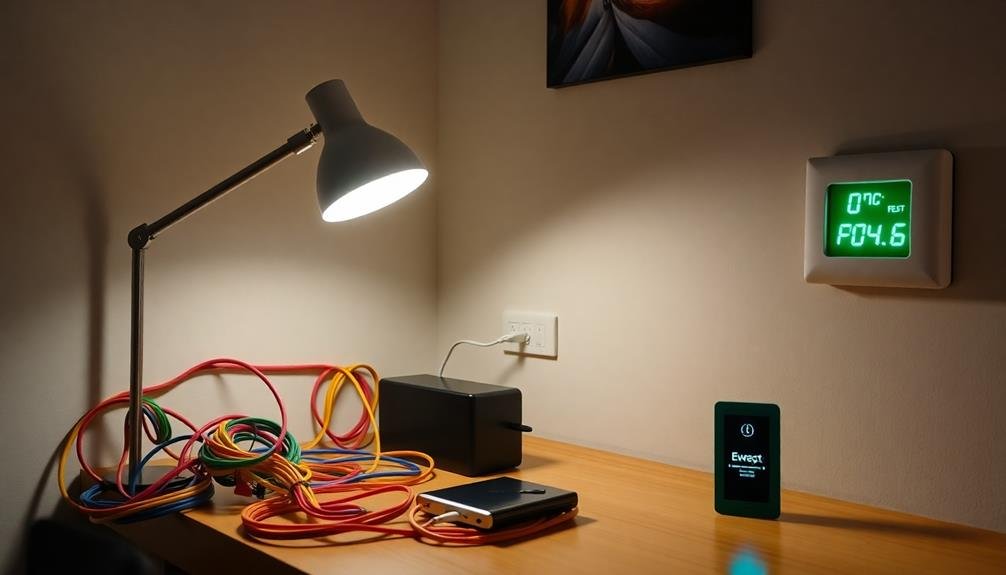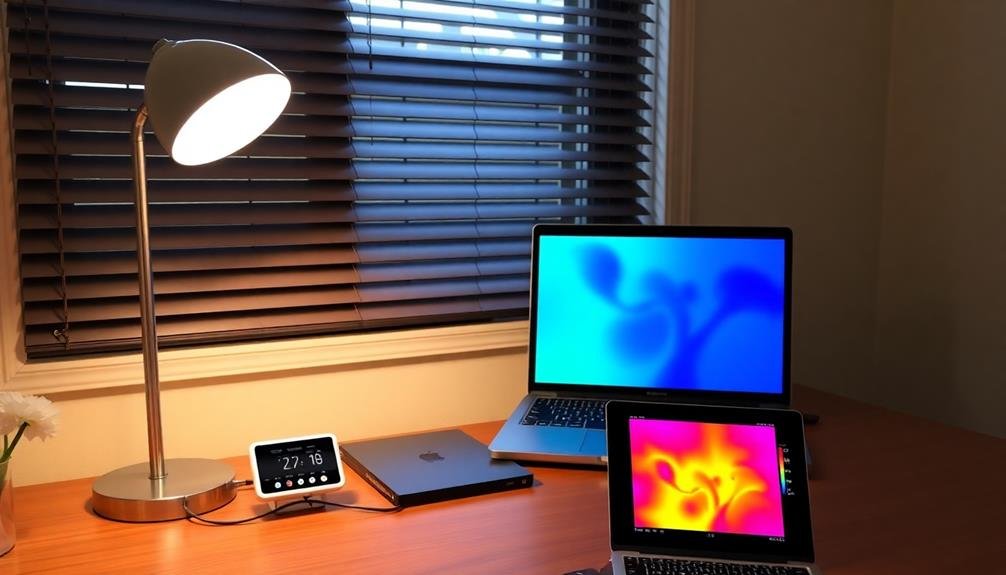You've likely noticed the growing trend toward renewable energy, and home wind turbines offer an accessible entry point into sustainable power generation. Whether you're looking to reduce your carbon footprint or trim your electricity bills, choosing the right beginner-friendly wind turbine kit can feel overwhelming. From compact vertical designs to extensive educational sets, the market's latest offerings provide diverse solutions for different needs and spaces. Let's explore your best options for 2025.
Wind Mill Generator Kit with Controller (12V-5000W)
The Wind Mill Generator Kit offers an ideal entry point for beginners seeking sustainable energy, with its remarkably low 2m/s starting wind speed and versatile 12V system. You'll appreciate its lightweight 2.2-pound design and compact dimensions, making installation straightforward on roofs, gardens, or farms.
The kit's three arc-shaped vertical blades, crafted from durable fiberglass and galvanized aluminum alloy, guarantee corrosion-resistant operation in temperatures from -40℃ to 80℃. Its intelligent microprocessor maximizes power tracking, while the three-phase AC permanent magnet generator delivers up to 5000W of clean, noise-free energy. For enhanced reliability, you can pair it with solar panels to create a hybrid power system.
Best For: Home and small property owners looking to experiment with renewable energy who live in areas with consistent light-to-moderate wind conditions and want a low-maintenance, entry-level wind power solution.
Pros:
- Exceptionally low starting wind speed of 2m/s makes it effective even in areas with lighter winds
- Lightweight and compact design allows for easy installation and flexible placement options
- Can be integrated with solar panels for a more reliable hybrid power system
Cons:
- Limited power output may not meet the full energy needs of larger households
- Low weight might affect stability in very high wind conditions
- Being from a lesser-known manufacturer, long-term reliability and warranty support may be uncertain
Thames & Kosmos Wind Power V4.0 STEM Experiment Kit
Aspiring young scientists and STEM enthusiasts will find the Thames & Kosmos Wind Power V4.0 kit an engaging introduction to renewable energy concepts. This educational kit lets you build a 3-foot wind turbine that charges batteries and powers a small model car.
While the kit offers valuable learning opportunities with its thorough manual and single-piece blade design, you'll face some practical challenges. The thin plastic base can be unstable in strong winds, and you'll need significant airflow to generate power. Despite being a 2021 Outdoor Toy finalist, many users report better results with indoor fan experiments than outdoor use. Consider this more as a teaching tool than a reliable power generator.
Best For: Children aged 11+ who are interested in renewable energy and willing to focus on the educational aspects rather than expecting consistent power generation performance.
Pros:
- Comprehensive educational manual with detailed information about wind energy concepts
- Single-piece blade construction provides good durability and aerodynamic performance
- Engaging STEM learning tool that demonstrates renewable energy principles through hands-on experimentation
Cons:
- Flimsy plastic base makes the turbine unstable in outdoor conditions
- Requires very strong wind or fan power to generate electricity effectively
- Unclear assembly instructions and some functionality issues with charging indicators and battery operation
Wind Turbine Generators Kit 12/24V with Axis Controller
Beginners seeking a versatile wind power solution will find the Wind Turbine Generators Kit particularly appealing due to its low startup wind speed and user-friendly design. The 5-blade vertical axis system delivers efficient power generation while maintaining low noise and vibration levels.
You'll appreciate the kit's adaptability for various applications, from home use to marine settings. Its unique lantern-shaped design isn't just aesthetically pleasing – it maximizes wind energy utilization. The permanent magnetic generator, combined with a special stator design, guarantees reliable performance and reduced resistance torque.
If you need support, their professional customer service team stands ready to help with any questions or concerns.
Best For: First-time wind power enthusiasts and homeowners looking for a versatile, low-maintenance renewable energy solution that can be used in various settings from residential to marine applications.
Pros:
- Low startup wind speed and quiet operation make it ideal for residential areas
- Versatile applications across home, marine, and monitoring uses
- Aesthetically pleasing design with efficient wind energy utilization
Cons:
- Limited to 600W power output which may not meet higher energy demands
- Requires professional installation for optimal performance and safety
- May need additional components for complete wind-solar hybrid system setup
Wind Turbine 1200W DC 12V Generator with MPPT Controller
Wind power enthusiasts seeking an entry-level turbine will find the 1200W DC 12V Generator with MPPT Controller to be an accessible starting point, thanks to its low start-up wind speed of 2.5 m/s and detailed installation kit.
The turbine's 5-blade PBT design and 4.27 ft rotor diameter maximize energy capture, while the MPPT controller offers essential protections, including overcharging prevention at 16.5V and discharge protection at 10.7V. You'll appreciate its durability with IP67 weather resistance and operating range of -30 to +80°C. At just 17.28 lbs, it's manageable for DIY installation, though you'll need to plan your mounting strategy carefully.
Best For: Small-scale residential users and off-grid enthusiasts looking for an entry-level wind power solution that combines decent power output with essential safety features and straightforward installation.
Pros:
- Low start-up wind speed of 2.5 m/s makes it effective even in areas with moderate wind conditions
- Comprehensive protection features including overcharging, discharging, and temperature safeguards
- Complete kit includes all essential components and is relatively lightweight at 17.28 lbs for easier installation
Cons:
- Mixed customer reviews (3.7/5 stars) suggest inconsistent performance experiences
- May require additional materials for mounting that aren't included in the package
- Limited power output of 1200W might not be sufficient for larger energy needs or complete off-grid solutions
Mini Vertical Wind Turbine Generator for Teaching & Science Experiments
Students and educators seeking hands-on renewable energy projects will find the Mini Vertical Wind Turbine Generator an ideal teaching tool. This compact device, featuring a 10cm fan diameter, comes in a set of two DIY kits perfect for classroom experiments.
You'll get output voltages between 0.01-5.5V and currents up to 100mA when powered by external airflow sources like fans or hair dryers. While it's not meant for actual power generation, you can use it to demonstrate electricity principles through various STEM projects including hand crank generators and mini hydropower setups. The removable parts let you customize turbine designs, making it excellent for students aged 6 and up.
Best For: Elementary and middle school teachers, STEM educators, and parents looking to introduce children (ages 6+) to renewable energy concepts through hands-on experiments and demonstrations.
Pros:
- Comes as a set of two complete DIY kits, allowing for parallel experiments or backup units
- Versatile educational tool that can demonstrate multiple power generation concepts (wind, hydro, hand-crank)
- Customizable design with removable parts that encourages experimentation and creativity
Cons:
- Requires external air source (fan or hair dryer) to generate electricity
- Lacks proper instruction manual for assembly and usage
- Limited power output makes it suitable only for demonstrations, not practical power generation
Wind Turbine 500W Vertical Axis Generator Kit with Controller
DIY enthusiasts seeking reliable renewable energy solutions will find the 500W Vertical Axis Generator Kit an excellent entry point into wind power. Its aluminum alloy blades and iron core permanent magnet generator deliver up to 500W output at 42.65ft/s wind speeds.
You'll appreciate the low noise operation (under 62dB) thanks to its precision double-bearing design. The automatic braking system kicks in at 300 RPM, ensuring safe operation. The weather-resistant plastic coating protects against the elements, while the flange mounting system makes installation and maintenance straightforward.
The kit's lower starting wind speed and efficient design make it ideal for both home and small business applications.
Best For: DIY homeowners and small business owners looking for an entry-level wind power solution that combines reliable performance with easy installation and maintenance.
Pros:
- Low noise operation under 62dB makes it suitable for residential areas
- Weather-resistant coating and automatic braking system provide excellent durability and safety
- Lower starting wind speed compared to conventional turbines increases overall efficiency
Cons:
- Limited power output of 500W may not meet larger energy needs
- Requires consistent wind speeds of up to 42.65ft/s for maximum output
- Initial setup may require professional guidance despite included instructions
Wind Generator 400W Hybrid Wind Turbine Generator Kit
For aspiring off-grid enthusiasts, the 400W Hybrid Wind Turbine Generator Kit offers a practical entry point into renewable energy generation. The three-blade turbine features a durable PBT construction and starts generating at 2.5m/s wind speeds.
While it's marketed as a 400W system, you'll typically see around 200W in real-world conditions, with peak output reaching 611W in 20-25 mph winds. You'll need consistent 10-12 mph winds for effective power generation. The DIY installation is straightforward, but you'll want to evaluate additional components like a rectifier for grid-tie applications. Despite quality construction, the small wind direction fin may limit performance in variable conditions.
Best For: DIY renewable energy enthusiasts seeking a supplemental power source for small applications like RVs, boats, or off-grid cabins where consistent moderate winds are present.
Pros:
- Easy DIY installation with included materials and sturdy aluminum construction
- Can achieve impressive peak output of 611W in optimal wind conditions
- Reliable performance in sustained winds of 10-12 mph with typical 200W output
Cons:
- Actual power output significantly lower than advertised 400W rating in typical conditions
- Small wind direction fin limits effectiveness in variable wind conditions
- Higher cut-in speed than advertised (7.5-8 mph vs claimed 2.5m/s) reduces overall utility
Factors to Consider When Choosing Top-Rated Home Wind Turbine Kits for Beginners
Before selecting a home wind turbine kit, you'll need to match your power needs with the turbine's output capacity while ensuring your local wind speeds can support efficient operation. You should evaluate your available installation space and verify any zoning restrictions that might affect mounting options or height limitations. Your budget must account for both upfront costs and ongoing maintenance requirements, which will vary based on the system's complexity and your comfort level with DIY repairs.
Power Output Requirements
Power output requirements stand at the forefront of selecting an appropriate home wind turbine kit. You'll need to calculate your daily energy consumption in watt-hours to determine the turbine size that matches your needs.
Most residential kits range from 400W to 5000W, so you'll want to choose one that aligns with your energy goals. Pay attention to the turbine's efficiency ratings, particularly its starting and rated wind speeds. Look for models that begin generating power at low wind speeds (around 2.5 m/s) and can operate effectively up to 25 m/s.
Don't forget to verify that the turbine's output voltage matches your battery storage system. This compatibility guarantees you'll maximize the energy you can capture and store for later use, making your investment worthwhile.
Wind Speed Conditions
Understanding local wind conditions is essential when selecting a home wind turbine kit. You'll need to verify that your area's typical wind speeds fall within the operational range of 2.5 to 25 meters per second, with a minimum of 2 m/s to start generating power.
For peak performance, check if your location's wind patterns match your chosen turbine's rated wind speed, which is typically around 12 m/s. Most turbines require sustained winds of 10-12 mph to generate power effectively. If your area frequently experiences winds below these thresholds, you might face reduced energy output.
Before investing, analyze your location's historical wind data. This research will help you choose a turbine that's properly matched to your local conditions, ensuring reliable power generation and maximizing your investment's value.
Installation Space Needed
Beyond wind speed assessment, selecting the right installation space stands as a fundamental decision for your home wind turbine project. You'll need to evaluate both vertical and horizontal clearance, with most turbines requiring at least 10 feet of height and a 5-10 foot radius free from obstacles.
Your installation site must have a robust foundation, often requiring a concrete pad or sturdy pole mount to handle wind forces. Don't forget to check your local zoning laws, as height and placement restrictions may limit your options. When choosing the location, you'll want to balance the distance from your home – far enough to minimize noise but close enough for easy maintenance access. Consider these spatial requirements carefully to guarantee your turbine operates efficiently and complies with local regulations.
Budget and Cost Analysis
Making a smart investment in a home wind turbine kit requires careful budget planning and cost analysis. You'll need to take into account several financial aspects before making your purchase. The initial kit price can vary greatly, ranging from hundreds to thousands of dollars based on power output capabilities.
Don't forget to factor in installation expenses, which might require professional help and additional materials. While higher-rated turbines cost more upfront, they often deliver better long-term energy savings. You'll also need to account for ongoing maintenance costs, including repairs and replacement parts that'll keep your system running efficiently.
To determine if a kit fits your budget, calculate your potential return on investment by comparing the total costs against expected energy savings. This analysis will help you choose a kit that balances affordability with performance.
Maintenance Skill Level
Three key maintenance factors deserve careful consideration when selecting a home wind turbine kit as a beginner. First, you'll need to assess your technical abilities honestly, as these systems require regular checks of blades, connections, and electrical components. If you're not comfortable with basic electrical work, you might want to choose a simpler system.
Second, consider the maintenance frequency required by different manufacturers. Some kits need more frequent attention, especially in challenging weather conditions. You'll want to match the maintenance schedule with your availability and willingness to perform regular upkeep.
Finally, look for kits that provide thorough documentation and support resources. A detailed manual or access to online tutorials can help you navigate maintenance tasks confidently, making the learning process more manageable and reducing potential frustration.
Local Weather Patterns
When selecting a home wind turbine kit, understanding your local weather patterns can make the difference between a successful installation and a disappointing investment. You'll want to guarantee your area maintains an average wind speed of at least 12 m/s for ideal turbine performance. Check your region's wind data for seasonal variations and the frequency of calm days, as these factors directly impact your energy generation potential.
Don't forget to assess your local topography, as hills and nearby buildings can create turbulence that reduces your turbine's efficiency. You'll also need to verify the maximum wind speeds in your area and potential extreme weather events. Choose a turbine that's rated to handle your local conditions – from the minimum cut-in speed of 2.5 m/s to the highest gusts your region experiences.
Frequently Asked Questions
How Loud Are Home Wind Turbines During Operation?
You'll hear between 35-45 decibels from most home wind turbines, similar to a quiet conversation. At higher wind speeds, they can reach 50-60 decibels, but that's usually masked by natural wind noise.
Can Wind Turbines Damage My Roof When Installed?
If you install your wind turbine incorrectly, it can damage your roof through vibrations and excess weight. That's why you'll need professional installation and proper mounting brackets to protect your roof's structural integrity.
Do I Need Special Permits to Install a Wind Turbine?
Yes, you'll usually need permits from your local government before installing a wind turbine. Check with your city's planning department, as requirements vary by location. Some areas also require HOA approval.
What Happens to Wind Turbines During Lightning Storms?
During lightning storms, your wind turbine's built-in lightning protection system directs strikes safely to the ground. You'll find most turbines also have automatic shutdown features that protect internal components during severe weather.
How Often Should Wind Turbines Undergo Maintenance Checks?
You'll need to inspect your wind turbine every 6 months for basic maintenance, but plan on a thorough professional check-up annually. Don't skip these checks – they're essential for safety and peak performance.





Leave a Reply